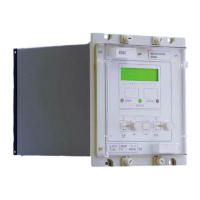VCG202/EN M/H11
Technical
The normally open contact is usually operated by direct movement of the tap changer’s
motor mechanism using the directional sequence switch or an interposing auxiliary relay.
In older static designs of VRR a contact which opened during each tap change step was
connected to isolate the measuring voltage to the VRR. The undervoltage inhibit was
arranged to reset the initial time delay to achieve the initial time delay for each tap
change. The KVGC202 can provide the same functionality whereby if the voltage falls
below the V<< undervoltage detector setting it will operate and instantaneously reset the
initial time delay thus inhibiting the relay outputs to ‘Raise’ or ‘Lower’ tap change
operations.
Figure 7: Initial delay used for multiple tap change sequence
For inverse initial delays the time delay between tap changes gets progressively longer
as the voltage deviation decreases. With definite initial delay settings the time delay
between each tap change is the fixed initial delay setting.
Method 2 rapidly corrects large voltage deviations, but greatly extends the total time the
voltage remains outside the deadband and is suitable only where load conditions will
tolerate this.
4.5 Line drop compensation
Throughout a voltage distribution network it is often required to regulate the system
voltage at a point remote to the regulating transformer, for example, the customer end of
a feeder. The remote system voltage is to be regulated within the deadband limits
irrespective of varying load current conditions. As such the regulating transformer is
required to supply the regulated system voltage, plus the voltage drop across the feeder.
Due to varying power factor requirements it is necessary to consider both resistive and
reactive components of the line drop voltage, separately. Line drop compensation (LDC)
provides a voltage proportional to the line drop voltage derived from the line load current,
which is vectorially summated with the measuring supply voltage so as to boost the
voltage output from the regulating transformer to supply the line drop and remote
regulated voltage, see Figure 8. Note, the voltage input and current input for LDC to the
KVGC202 are quadrature (90°) connected i.e. IA (terminals 27-28) and VBC (terminals
17-18). Correct LDC can also be achieved with other quadrature connections IB and
VCA or IC and VAB.
In the KVGC202 the resistive and reactive line drop voltage, Vr and Vxl are calculated as:
Vr =
3 x Ip x RL
VT_ratio
Vr =
3 x Ip x XL
VT_ratio

